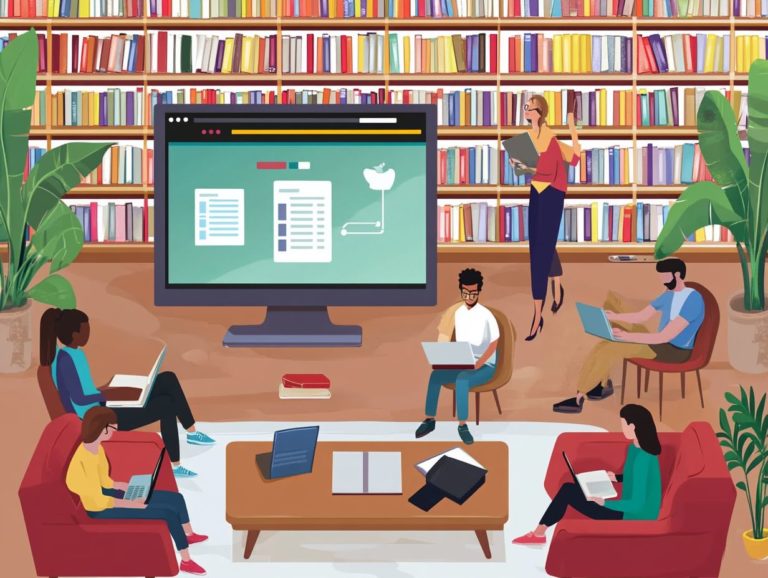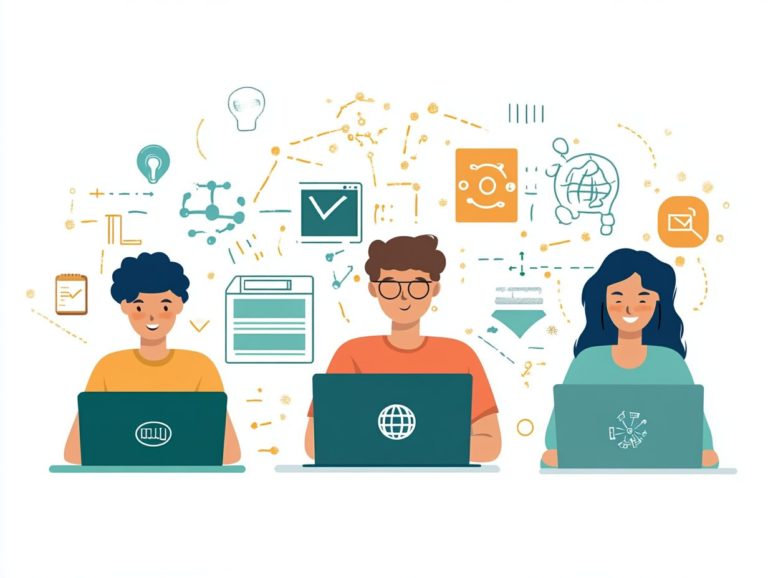5 Emerging Technologies in E-Learning
As education evolves, you ll find that the tools enhancing the learning experience are evolving right alongside it.
Consider exploring five emerging technologies Virtual Reality, Gamification, Augmented Reality (overlaying digital information on the real world), and Adaptive Learning that are poised to shape the future of e-learning. These innovations have the potential to craft more engaging, personalized, and effective educational environments.
You ll delve into the benefits and challenges of integrating these technologies, their applications across various learning scenarios, and how educators can prepare for this exciting transformation. Dive into the exciting future of learning today!
Don t miss out on the chance to enhance your learning experience with these emerging technologies!
Contents
- Key Takeaways:
- 1. Virtual Reality
- 2. Artificial Intelligence
- 3. Gamification
- 4. Augmented Reality
- 5. Adaptive Learning
- Imagine Transforming Your Learning Experience with Exciting Tools!
- What Are the Benefits of Using These Technologies in E-Learning?
- What Are the Potential Challenges of Implementing These Technologies?
- How Can These Technologies Be Used in Different Types of E-Learning?
- What Are the Future Possibilities for These Technologies in E-Learning?
- How Can Educators Prepare for the Integration of These Technologies in E-Learning?
- Frequently Asked Questions
- What are the 5 emerging technologies in e-learning?
- How is virtual reality being used in e-learning?
- What role does artificial intelligence play in e-learning?
- What is gamification and how is it being incorporated in e-learning?
- How is mobile learning changing the landscape of e-learning?
- What is big data analytics and how is it benefiting e-learning?
Key Takeaways:
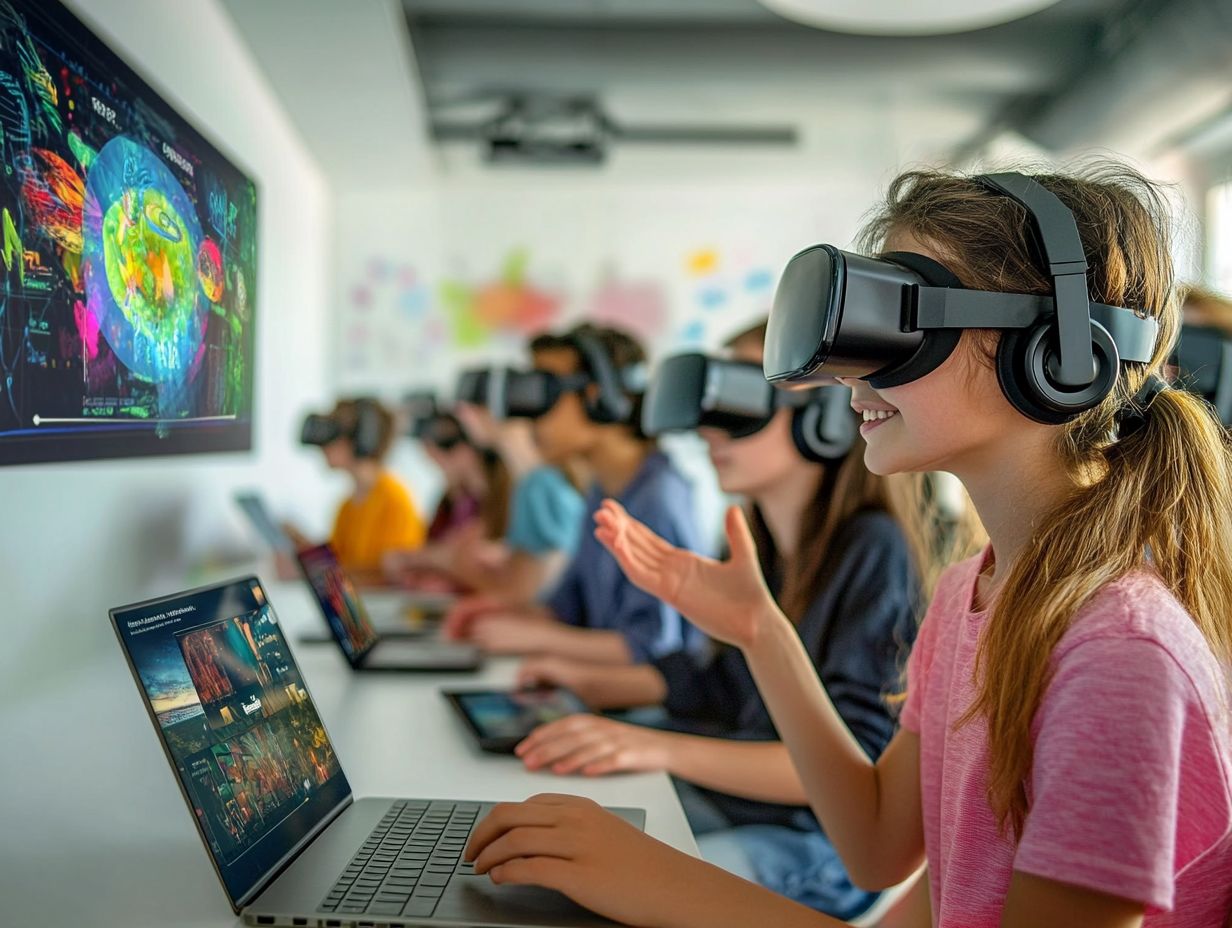
- Virtual Reality can create immersive learning experiences, increasing engagement and retention.
- Artificial Intelligence can personalize the learning journey, adapting to each student s needs.
- Gamification can make learning more interactive and fun, motivating students to actively participate.
1. Virtual Reality
Virtual Reality (VR) has emerged as a new technology in e-learning, offering immersive experiences that captivate and engage you in ways traditional methods simply cannot. By leveraging the capabilities of VR, educators can utilize tools for creating interactive e-learning and craft engaging learning environments.
This technology transports you beyond the confines of the classroom, allowing you to delve into complex concepts within a simulated world, stimulating your curiosity and fostering a deeper understanding through learning by doing.
Imagine studying subjects like physics or history through virtual journeys to space or ancient civilizations making the content not just relatable but visually captivating. The interactivity that VR promotes can lead to retention rates that far surpass those of conventional learning methods.
When you combine VR with wearable devices and augmented reality, the result is a seamless navigation of digital landscapes while remaining connected to your physical surroundings. This creates a holistic learning experience that enriches your education.
However, integrating such innovative technology isn’t without its challenges. It requires significant investment in infrastructure and training for educators to leverage these tools effectively. As schools and institutions strive to overcome these obstacles, the potential for VR to revolutionize your learning landscape remains immense.
2. Artificial Intelligence
Artificial Intelligence (AI) is transforming the e-learning landscape, creating personalized learning experiences tailored just for you. With AI-driven tools at your fingertips, educators can analyze your learning behaviors and outcomes through advanced learning analytics, enabling them to adapt content and instruction to fit your unique style and pace.
As AI continues to evolve, its applications in automated grading and predictive analytics (using data to predict future learning outcomes) will further enhance the effectiveness of educational technologies, making it an essential part of modern classrooms.
AI also identifies areas where you might struggle, allowing for targeted interventions that can help you excel. When AI integrates with other technologies like virtual reality and augmented reality, it opens up thrilling possibilities for immersive learning experiences.
Picture yourself exploring historical events through interactive simulations or practicing a new language in virtual environments where you can converse with AI-powered avatars. The ongoing evolution of AI tools hints that, in the future, adaptive learning platforms could become even more intuitive, cultivating a learning atmosphere that is not only efficient but also engaging for you across a range of educational contexts.
3. Gamification
Gamification in e-learning introduces game-like elements into your educational journey. This significantly enhances your engagement and motivation.
By incorporating points, badges, leaderboards, and challenges, educators turn learning into an interactive adventure that inspires you to achieve better outcomes. This approach encourages collaboration through social learning and effectively addresses knowledge gaps by making educational content enjoyable.
Take platforms like Kahoot! and Classcraft, for instance. They showcase the power of gamified systems, allowing you to compete in a fun environment while you learn. These tools enrich your experience by providing immediate feedback and fostering a sense of community among peers.
As e-learning continues to evolve, the significance of gamification becomes clear. It aligns perfectly with trends that prioritize personalized education and learner autonomy. Gamification captivates your attention and enhances knowledge retention, transforming learning into a rewarding journey rather than a mundane task.
4. Augmented Reality
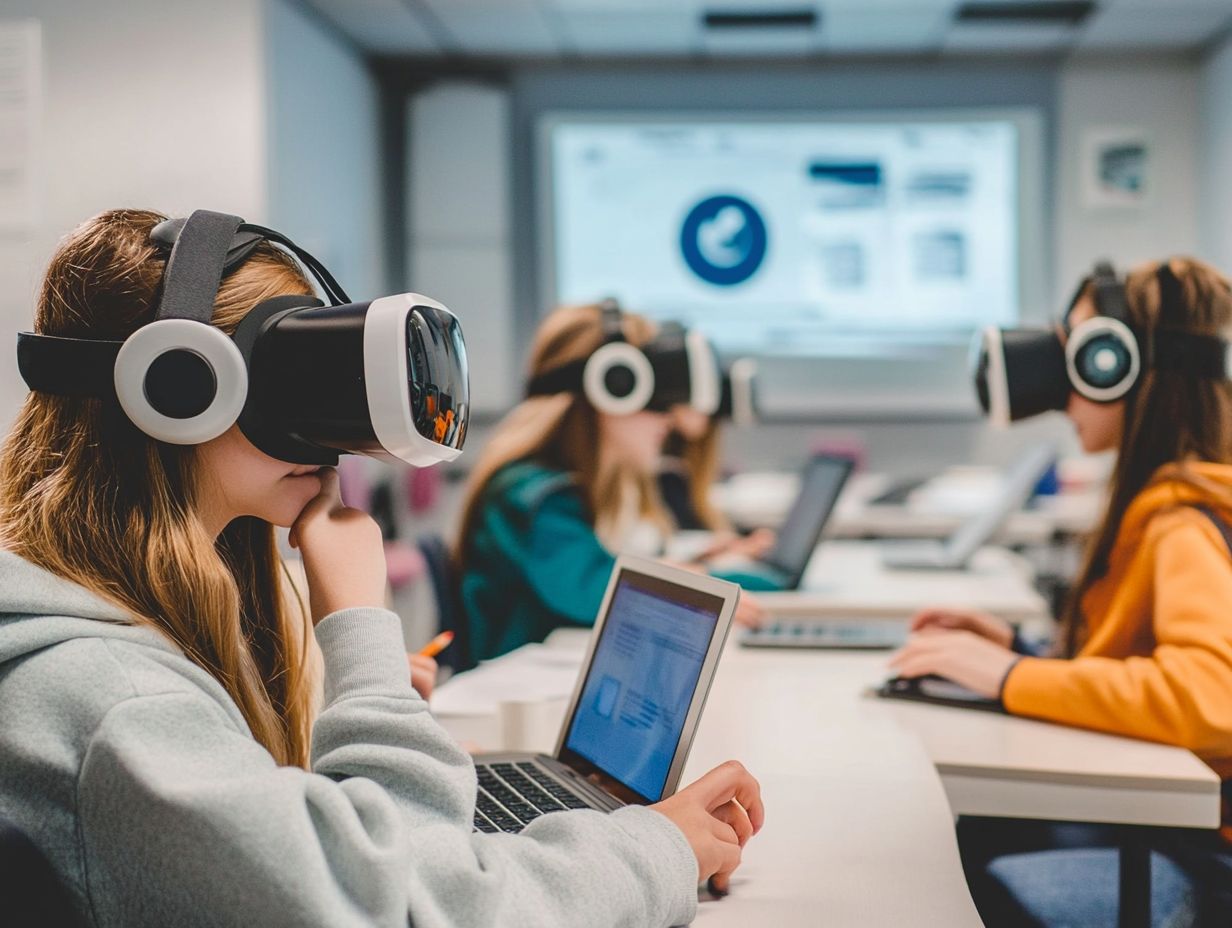
Augmented Reality (AR) transforms your learning experience by layering digital information over the real world. It creates immersive interactions that engage you in remarkable ways.
With mobile learning platforms at your fingertips, accessing AR becomes easy. You can interact with educational materials and training programs in an engaging manner.
For example, applications like Google Expeditions let you embark on virtual field trips to historical sites. Platforms like AR Flashcards turn biology into a fun, interactive adventure. The immersive nature of AR piques your interest and significantly boosts retention rates.
With mobile access, education can break free from traditional classrooms, fostering a versatile learning environment. When AR integrates with other technologies, such as online learning platforms, it creates a comprehensive educational toolkit that caters to diverse learning styles while promoting collaboration among you and your peers.
5. Adaptive Learning
Adaptive Learning stands as a remarkable leap forward in personalized education. It harnesses technology to create learning experiences tailored to your performance and needs.
By diving into data through learning analytics, adaptive systems adjust content in real-time. This ensures you encounter just the right level of challenge and support. This method boosts your engagement and champions competency-based education, allowing you to progress at your own pace while effectively filling any knowledge gaps.
More schools are realizing how these technologies can improve learning. Adaptive learning tools elevate traditional methodologies by using smart systems that monitor student interactions. This provides insights that educators can use to fine-tune their teaching practices, creating a more enriching experience for you.
Looking ahead, you can anticipate that adaptive learning will continue to evolve, possibly incorporating artificial intelligence and predictive analytics. This evolution is set to completely transform how you learn and interact with educators, making your experience even more dynamic and impactful.
Imagine Transforming Your Learning Experience with Exciting Tools!
Imagine transforming your learning experience with exciting tools like Virtual Reality, Artificial Intelligence, Gamification, Augmented Reality, and Adaptive Learning. Discover 5 popular e-learning tools for corporations that engage you in meaningful ways, offering personalized and interactive learning opportunities that cater to your unique style.
By embracing educational technologies, you can enjoy immersive experiences that enhance your performance and outcomes while effectively addressing your individual needs.
For instance, Virtual Reality lets you dive into complex environments or historical events, giving you firsthand understanding that traditional methods simply can’t match.
Adaptive Learning adjusts content to your progress, ensuring you grasp concepts at your own pace. Gamification elements, such as rewards and challenges, make learning enjoyable, while Augmented Reality overlays digital information onto real-world settings, inviting you to interact and explore.
Together, these technologies not only elevate your engagement but also supercharge your memory, paving the way for enhanced academic performance.
What Are the Benefits of Using These Technologies in E-Learning?
Utilizing advanced technologies in e-learning presents a wealth of benefits:
- Heightened student engagement
- Improved learning outcomes
- Dynamic and interactive learning environments
- Personalized approaches
By implementing technology-enhanced strategies, you inspire students to take an active role in their education. Imagine leveraging tools like Virtual Reality and gamified learning platforms to immerse students in experiential learning scenarios, making complex subjects feel more relatable. This approach addresses the challenges of traditional classrooms, like those one-size-fits-all teaching methods that often overlook individual struggles.
Data analytics help you track student progress in real-time, allowing for tailored interventions. This creates a more inclusive educational landscape, where every student has the opportunity to thrive.
What Are the Potential Challenges of Implementing These Technologies?

Despite the promising benefits, you may encounter several challenges during implementation:
- Resistance to technology adoption
- The necessity for teacher training
- Equitable access to digital tools for all students
You ll need to navigate the complexities of adapting traditional learning behaviors to accommodate new technology-enhanced environments, which can feel daunting for both educators and students alike.
For example, a survey by the International Society for Technology in Education revealed that nearly 40% of teachers felt ill-equipped to effectively integrate new technologies into their curriculum. A case study from a school district that implemented a one-to-one device program showed that nearly 30% of students lacked reliable internet access at home, further widening the digital divide.
Proper planning and ongoing support from administrators are essential in addressing these gaps, ensuring you and fellow educators receive the necessary training and resources. By prioritizing these elements, institutions can better navigate the hurdles posed by technological advancements in education.
Are you ready to embrace these tools and elevate your learning journey?
How Can These Technologies Be Used in Different Types of E-Learning?
The application of advanced technologies in e-learning can be tailored to suit your preferred learning format, whether it’s distance learning, blended learning, or fully online courses. Implementing ways to enhance accessibility in e-learning ensures that all learners can benefit from these options.
Each of these e-learning types has the potential to leverage cutting-edge tools like Virtual Reality, Artificial Intelligence, and Gamification to enhance personalized instruction. For inspiration, check out these innovative e-learning case studies. These tools also foster interactive learning environments.
For instance, in a distance learning setup, Virtual Reality can transport you into immersive training scenarios that would otherwise be out of reach. Meanwhile, in blended learning formats, Artificial Intelligence can provide you with individualized feedback and support.
It can adjust lessons based on your progress and challenges. Gamification techniques can significantly elevate your motivation and retention in fully online courses.
By incorporating competitive elements and rewards, these techniques encourage you to actively participate and engage more deeply with the material. This adaptability showcases how technology can revolutionize educational practices.
It makes your learning journey not only more effective but also far more enjoyable across various platforms.
What Are the Future Possibilities for These Technologies in E-Learning?
The future of e-learning presents a wealth of possibilities, with successful e-learning implementation serving as a key example. Emerging technologies like 5G, blockchain, and the Internet of Things continue to evolve and transform educational experiences.
These innovations offer seamless connectivity, enhanced security for digital resources, and personalized learning journeys driven by data insights.
These technologies are gaining momentum and will further enrich e-learning, highlighting the 5 essential features of effective e-learning tools to create a more engaging and effective environment for learners.
As you look ahead, adopting a proactive approach is essential. Incorporating professional development for educators is crucial to ensure they have the skills to navigate these new tools with confidence.
Collaborative platforms can foster connections among educators worldwide. This paves the way for an exchange of ideas and best practices that enrich teaching methodologies.
Schools must seize the opportunity to experiment with innovative curricula that harness these emerging technologies. This allows students to dive into interactive lessons tailored to various learning styles.
By embracing this evolution, educational institutions can prepare for a future where e-learning remains relevant and evolves into a cornerstone of holistic education.
How Can Educators Prepare for the Integration of These Technologies in E-Learning?
Educators hold a pivotal position in seamlessly integrating technologies into e-learning. This calls for thoughtful preparation and continuous professional development.
To truly harness innovative tools and methodologies, engage in training programs designed to arm you with the essential skills and knowledge needed to use user-friendly technologies effectively.
By fostering a culture of collaboration and openness to new approaches, you empower yourself to adapt your teaching practices. This ultimately enhances learning outcomes for your students.
Preparation also involves strategic resource allocation, ensuring that your school has access to the necessary tools and platforms for effective technology use.
Building strong community support is crucial, as it cultivates an environment where you and your peers can share experiences and best practices.
Adopting a growth mindset isn’t just beneficial for your students; it encourages you to view challenges as opportunities for personal and professional growth.
This fosters resilience in the face of technological changes. Ultimately, these strategies contribute to a more dynamic and responsive educational landscape.
They transform the learning experience for everyone involved.
Frequently Asked Questions
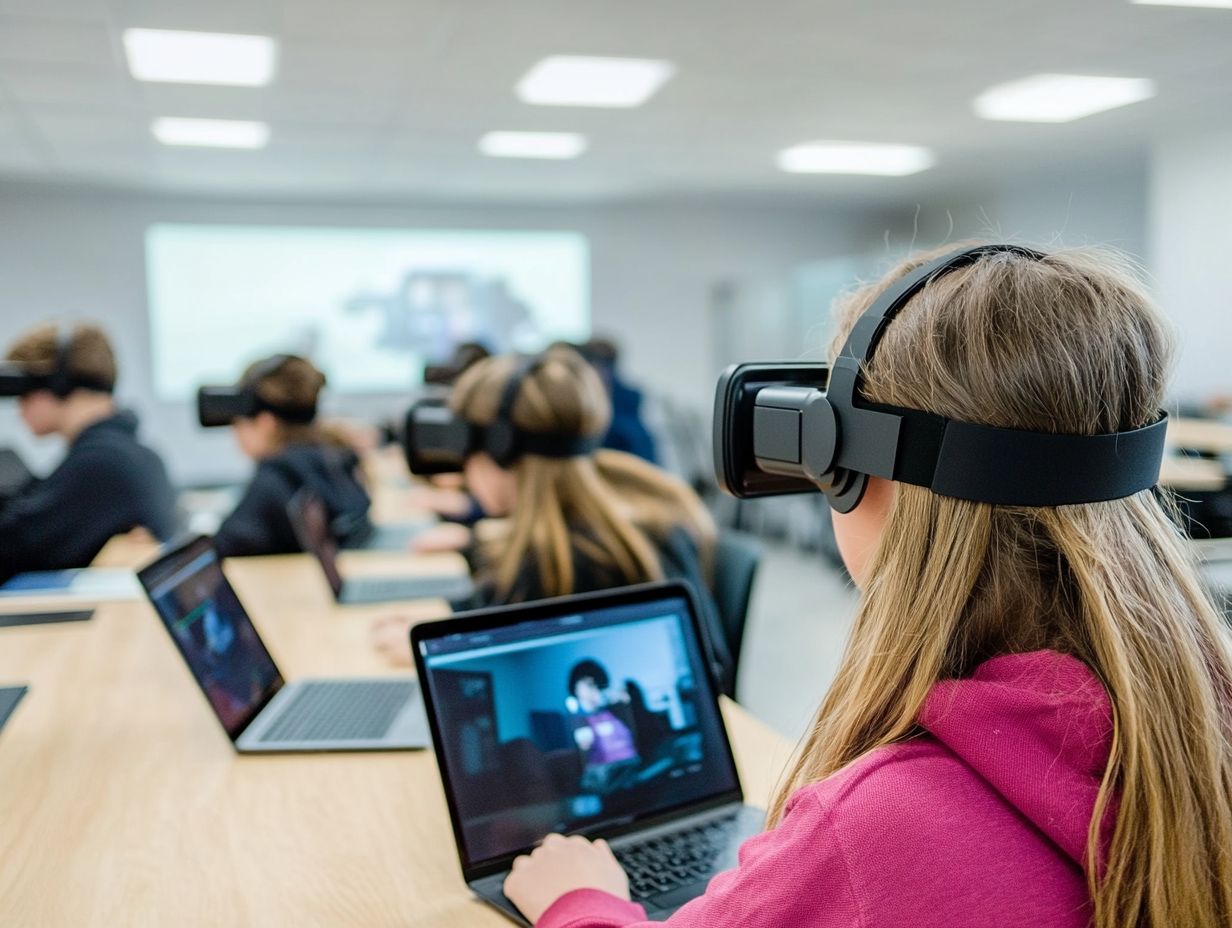
What are the 5 emerging technologies in e-learning?
The 5 emerging technologies in e-learning are Virtual Reality, Artificial Intelligence, Gamification, Mobile Learning, and Big Data Analytics.
How is virtual reality being used in e-learning?
Virtual reality creates immersive and interactive learning experiences. Learners can practice skills in realistic environments, making education exciting and effective.
What role does artificial intelligence play in e-learning?
Artificial intelligence personalizes learning for each individual. It tailors courses to fit unique needs, making learning more engaging.
What is gamification and how is it being incorporated in e-learning?
Gamification adds game-like elements to learning. This approach boosts engagement and motivation, transforming education into a fun experience.
How is mobile learning changing the landscape of e-learning?
Mobile learning, or m-learning, enables learners to access courses anytime, anywhere. This flexibility makes education more convenient and accessible.
What is big data analytics and how is it benefiting e-learning?
Big data analytics means collecting and interpreting large data sets. It helps educators understand learner behavior, leading to better course design and delivery.

